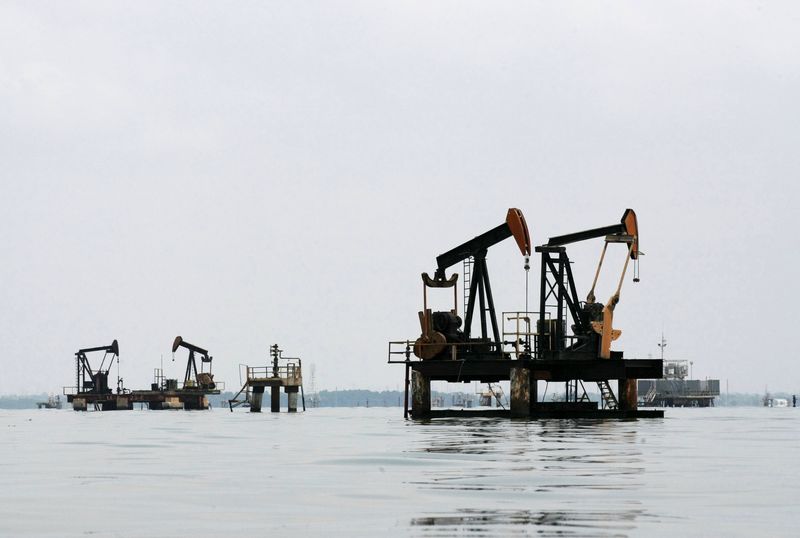(Bloomberg) --
Crude supplies from OPEC’s Middle East oil exporters, excluding Iran, rose for a fourth month in March to the higest level since at least January 2017. The surge came before a production free-for-all triggered by ministers’ failure early last month to agree an extension of the OPEC+ output deal.
Saudi Arabia, Iraq, Kuwait and the United Arab Emirates, which together account for about 70% of OPEC’s entire production, together shipped an average of 16.9 million barrels a day of crude and condensate last month, tanker-tracking data compiled by Bloomberg show. That was an increase of 500,000 barrels a day from revised February levels and came as Saudi Arabia geared up to meet its pledge to boost supplies to the market after the collapse of the OPEC+ output deal.
Saudi shipments in March rose by 430,000 barrels a day, or 6%, from their February level, averaging 7.39 million. That was the most since the kingdom boosted output in late 2018, as the country makes good on its pledge to ramp up oil exports in April. Flows from the country’s Yanbu terminal on its Red Sea coast jumped by about 64% to 1.13 million barrels a day, with the additional shipments going into storage tanks on Egypt’s Mediterranean coast.
Iraq’s exports rose month on month by almost 60,000 barrels a day, to their highest level in four months. A small drop in shipments from its Basra oil terminal, which fell by about 20,000 barrels a day to 3.38 million, was more than offset by an increase in flows from the north of the country through the Ceyhan terminal on Turkey’s Mediterranean coast. Northern exports rose by more than 80,000 barrels a day to their highest level in 10 months.
Flows from Kuwait fell month-on-month in March, dropping by 2.5% from the daily average level seen in February. While shipments to most Asian destinations dipped, cargoes bound for South Korea surged to the highest in at least 21 months while flows to India also swelled.
The U.A.E. shipped more than 100 million barrels of crude and condensate in March, for the first time in at least three years, aided by a surge in flows to China.
Observed shipments from Iran have been excluded, as tankers leaving the country often only appear in tracking data several weeks later, once they have reached choke-points like the Strait of Malacca or the Suez Canal, making early assessments of flows from the country less reliable. Tracking signals from eight tankers carrying an estimated 10.7 million barrels of Iranian crude or condensate appeared during March. That’s the highest volume of observed exports since October. China and the east Mediterranean were the only observable destinations for the ships carrying Iranian crude.
With more than 49 million barrels of oil on ships from OPEC’s Middle East exporters yet to signal a final destination, estimates of flows to individual countries are subject to revision.
Persian Gulf crude flows to India, the closest major market, were virtually unchanged in March from the previous month’s level of 2.6 million barrels a day. Shipments from Saudi Arabia were down by 90,000 barrels a day, or 12%, while flows from Iraq fell by 45,000 barrels a day, or 4%, but these drops were offset by increased volumes from Kuwait and the U.A.E. India’s oil refiners are slashing crude-processing rates, as a three-week lockdown to stem the spread of the coronavirus pandemic crushes energy demand.
Flows to the U.S. remained subdued in March, with initial vessel destination data indicating a combined flow of over 500,000 barrels a day from Iraq and Saudi Arabia. Saudi shipments were 290,000 barrels a day, although that figure could rise, as 28.5 million barrels of Saudi crude is on ships that have yet to signal a final destination. A voyage time of about six weeks to both the East and West Coasts of the U.S. means that actual flows often don’t become apparent for several weeks after loading.
Observed shipments from Persian Gulf OPEC countries, excluding Iran, to China fell sharply in March, dropping to an 11-month low. By mid-March, run rates at China’s oil refineries were down by about 3 million barrels a day compared with December, reducing their need for imported crude.
Shipments from the region to Japan fell back in March after rising in February. Flows to Japan from the U.A.E. fell to their lowest in a year, while shipments from Saudi Arabia rose to a four-month high. One VLCC of crude left Iraq for Japan in March, the first cargo to make the journey this year.
Flows to South Korea, the other big Asian buyer of Persian Gulf crude, fell by 195,000 barrels a day, or 11%, in March. The biggest drop in volume terms came from Saudi Arabia, where shipments were also down by 195,000 barrels a day, or 23%, as refiners cut runs by more than initially planned. SK Innovation, South Korea’s biggest refiner, said it would cut processing at its crude distillation units by 10%-15% in March, as the coronavirus crimps demand. That compared with an earlier plan for a 5%-10% reduction.
Note: The figures above include exports from northern Iraq via Ceyhan in Turkey and outflows from the U.A.E.’s Indian Ocean coast and from Saudi Arabian Red Sea ports. They include crude and condensates, a light form of oil extracted from gas fields. Figures for flows to individual destinations are subject to change, especially when ships pass transit points like Singapore and the Suez Canal.
- Bloomberg Terminal users can click on NI TANTRA for all tanker tracking stories, ALLX CUAG for tickerized data for Persian Gulf OPEC flows, and LINE GBLCRUDE for an overview of Bloomberg tanker tracking.
©2020 Bloomberg L.P.
